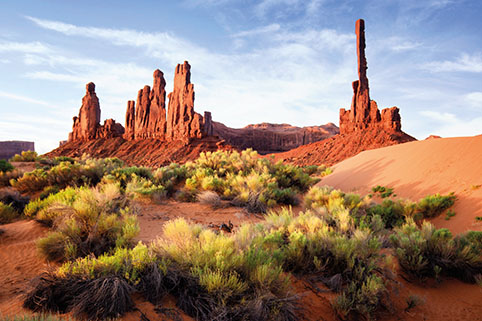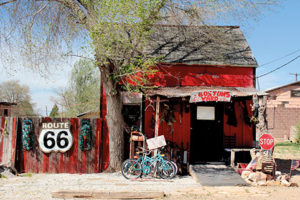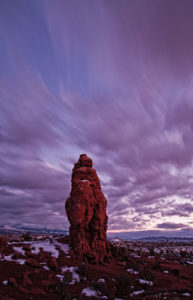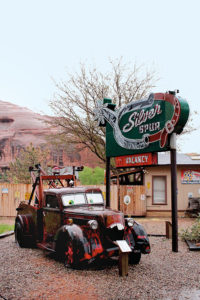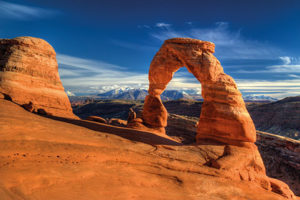A stone’s throw from Sin City, the boulder-studded canyons of southern Utah and the desert badlands of south-western Arizona are balm for the soul,
discovers Keith Bain
As I sat nursing my bottomless coffee in Seligman’s world-famous Roadkill Cafe, much of what had gone down in Las Vegas remained a blur, as though a curse had befallen me. I was glad to have slipped away from Sin City in one piece, escaping east along the scattered remains of Route 66 instead of waking up in an ice bath, having sold a kidney to finance another losing streak at the roulette wheel.
Feeling miserable and poor, I scanned the walls of the diner, wondering if I was any better off than the stuffed animals that stared back down at me with their glazed eyes.
Then the Stranger in a Stetson leaned over and began a conversation I had no way of backing out of.
‘Stung by Vegas, huh?’ he said in his drawl. ‘Well, ain’t that a shame.’
When I told him I’d stumbled on to Route 66 quite by chance and was now looking to find the Grand Canyon, he pulled a road map from his back pocket and drew a route with his finger. Then he tapped the map thoughtfully and pointed out a few more stops worth detouring for.
‘Do it properly,’ he said, ‘and it will mend your sore heart.’
Route 66 unfolds eastwards like a film set dotted with one-horse towns, remnants of a time when the 4 000 km road from Chicago to Los Angeles was a symbol of the American Dream. Northern Arizona contains its best-kept bits – old storefronts, ’40s gas stations and motels that feel like museums. Once the Main Street of America, it was decommissioned in the mid-80s and began disappearing from maps when it was bypassed by interstate highways.
But navigable stretches of old asphalt remain, blacktop linking unconventional and curious places, most of them now almost entirely transformed into shrines to Route 66 – like the town of Seligman. Or Hackberry, a pick-up-truck graveyard attached to a general-store-cum-petrol- station with a museum of crazy road signs, animal skulls pinned to wooden posts and quirky artworks made from junk found all along the highway – not to mention a collection of vintage cars.
Following the Stetsoned Stranger’s advice, I spent a night in Williams, the last Route 66 town to be bypassed by Interstate 40 – and the nearest to the Grand Canyon. Founded in the 1800s and fringed by Ponderosa pine forest, it’s lined with vintage reminders of its Mother Road heyday – soda fountains and Elvis-era diners, flashing neon signs, vintage storefronts and a strip of old, cheap motels.
The Grand Canyon’s South Rim lies just an hour north and I arrived early enough to gawp as the first golden rays of sunlight poured into the river-carved abyss, throwing its crags and sheer cliffs into a medley of ever-changing colours. Striated bands of rock create intricate patterns, giving the vast, deep canyon walls a layered, painterly appearance that appears beyond science or geology – a three-dimensional artwork in exuberant colours, on a scale beyond imagination.
I stared and gawked and craned my neck until I realised I was holding my breath trying to wrap my head around the time and forces required to carve something this vast out of solid rock.
I spent part of the day hiking down one of the old donkey trails to get the sense of being immersed in the canyon, and then joined the crowd of sunset worshippers gathering to witness the canyon as it turned phosphorescent shades of rust and ochre before nightfall. Once the entire world had been consumed by darkness, I checked into one of the park’s cabins, and made sure I was up early to stare at it all over again.
Eventually, I dragged myself south to visit the New Age hub of Sedona. Built amid astonishing red rocks and boulders, the town is said to be charged by a special force because of its location at the convergence of powerful energy vortices. Well, whatever the local hippies believe, it’s one of the most handsome inhabited places I had ever seen and I spent hours walking along the trails that weave through its red-coloured rock mounds, with names like Coffee Pot, Cathedral and Thunder Mountain.
Afterwards, I slunk into an organic cafe and eavesdropped on conversations extolling the virtues of crystal healing and colonic irrigation.
Back on 66, I passed the remnants of ambitiously named Meteor City, now nothing more than a derelict trading store, and whipped through Winslow, another Wild West-era town that never quite achieved its ambition of becoming one of the US’s biggest cities.
Farther up the old route, in Arizona’s remote north-east, I arrived at the barren badlands of the Painted Desert, named for the pastel shades – orange, lavender, grey, pink and vivid red – that make its hills and eerily pockmarked plains look as though they have been rendered by an artist’s brushstroke.
Then I turned the car back west to Monument Valley on the Arizona-Utah border, where mesas rise from the dusty desert like gigantic sculptures. Part of the Navajo Nation, a semi-autonomous territory encompassing lands held sacred by people who’ve lived there since time immemorial, the 120 km² tribal park contains some of the most recognisable scenes in American pop culture, with its towering rock formations having served as backdrops for such iconic films as the John Wayne westerns Stagecoach and The Searchers.
I drove Monument Valley’s 27 km circular dirt road, stopping frequently to ogle monoliths jutting up from the bone-dry, red, sandy desert like gigantic totem poles. Here, admiring the scores of sandstone buttes arrayed against the sweeping sagebrush, I glimpsed what true frontier country must have looked and felt like. I spent the night at the park’s smart, sunrise-facing hotel and, the next morning, watched the sculpted landscape burn red and orange and gold as the sun rose above the valley.
I continued north into Utah – not only Mormon headquarters, but also full of pristine parklands set aside for their unique geological formations, such as the seemingly countless canyons of Canyonlands National Park, where I spent just enough time to get the gist of a world that appeared to belong to another planet.
I arrived in the adventure-seekers’ town of Moab just before nightfall and spent the next few days hiking through different parts of Arches National Park, home to the largest concentration of natural sandstone arches on the planet, including the famous ribbon of stone known as Delicate Arch, chiselled over aeons by the impact of water, airborne sand and eroding winds.
Apart from its 2 000-or-so arches, the park boasts countless more formations carved from the hard-wearing Colorado Plateau. I walked through humongous natural galleries enfolded by colossal sandstone fins, delicately balanced rocks, soaring pinnacles and needle-shaped spires thrusting towards the sky. And while trekking across, under and over immense boulders and smooth-moulded cliffs, I witnessed a sudden shift in the weather, which transformed dazzling sunshine into biting cold accompanied by awesome bolts of lightning.
Like so much of south-eastern Utah, Moab is full of people who have given up the stressful urban life in favour of the ultimate outdoorsy lifestyle. Which explains why the place is jam-packed with artisanal stores where reformed city folk now proffer giant scoops of home-made bourbon-flavoured gelato or sell pints of their microbrewery’s tasty Dead Horse Amber Ale.
When I had had my fill of arches, I pointed the car west, cutting through the wondrously scenic Dixie National Forest to reach Bryce Canyon, where literally thousands upon thousands of another strange kind of rock formation fill a vast, arid basin. Creatively named ‘hoodoos’ by early amateur geologists who believed them capable of casting spells upon anyone who laid eyes on them, these weird rock pillars rise up from the earth like grotesquely shaped sentinels, some of them reaching the height of 10-storey buildings.
Finally, I found myself standing in Zion National Park, staring up at the sharp-rising mountains on the sides of the narrow slot canyon, where the Navajo Sandstone peaks have been given names such as Weeping Rock, Angels Landing and The Three Patriarchs.
I climbed on the bus for the journey to the Temple of Sinawava, the starting point for a hike through The Narrows, the slenderest section of Zion Canyon. There isn’t any trail. Instead, I waded upstream, following the Virgin River through the narrow gap it has carved at the base of the red and pink sandstone cliffs that tower 300m overhead.
The next day, I followed an uphill path to get a look at the gorge from a different perspective. I hiked through thick forest beset by beautiful waterfalls and moss-covered boulders, and found myself in yet another kind of paradise, once again dwarfed and humbled by the walls of ancient rock that surrounded me now.
It was difficult to believe that a mere hour-or-so away from this unfettered wilderness lay the pulsating energy of Vegas. I’d been gone merely a week and – as the Stranger had promised – felt revived, my heart mended, the curse lifted. Now all I had to do was get to the airport before the casinos could lure me back in.
GOOD TO KNOW
The basics
Las Vegas is the most obvious first point of arrival for trips into southern Utah and across northern Arizona. Holders of SA passports require a visa for entry to the US, and this should be acquired well in advance of your planned travel dates.
The parks are busiest between March and October – winter can be extremely cold and heavy snow is not uncommon.
The US National Park Service is efficient, helpful and designed to make visiting the country’s natural treasures as pleasant as possible, while maintaining the integrity of what’s protected. If you intend seeing more than a couple of parks, it’s worth obtaining an America the Beautiful pass, allowing you a full year’s worth of unlimited national park entries (not including Monument Valley or any state-run parks). Passes are available at park entrances.
www.nps.gov
Getting there
A number of international airlines now offer non-stop flights to Las Vegas from various European hubs. You can also book a non-direct route with airlines flying to the US from South Africa (such as SAA or Delta, which is likely to be the quickest and also the most affordable), or fly into the US and pre-book a low-cost domestic flight to Vegas.
Getting around
Hire a car or, if you’d like to avoid the hotel costs, rent a Winnebago-style caravan (aka RV, ‘recreational vehicle’). Caravan parks, designated ‘RV sites’, are found throughout the region, especially in the vicinity of national parks. Car rentals and fuel prices are very reasonable compared with South Africa.
Booking online in advance and ensuring that full insurance is included in the cost will give you the best rate; although, if you have time to shop around after arrival in Vegas, you’re likely to find heavily discounted rates. Remember that gas stations in the US are self-service – and you can usually buy fuel using a credit card. Drive on the right and remember that speed limits and distances are posted in miles.
Where to stay
The towns in this area are packed with low-priced motels, the majority of which advertise their rates within easy view of the road. If you do not mind carrying around camping equipment (which can be bought relatively affordably once you arrive), there are also good-value campgrounds with well-maintained facilities in and around most of the parks.
Campsites within popular parks such as Zion and Arches will need to be booked well in advance – they are often fully booked up throughout busy periods (March to October). www.nps.gov
Even better than staying topside at the Grand Canyon’s South Rim is overnighting at Phantom Ranch, on the Canyon’s floor. Advance booking for accommodation is essential, as well as for guided mule trips into the Canyon and any arrangements to have your bags transferred by pack mule. www.grandcanyonlodges.com.
There are a number of options to be had in Monument Valley Navajo Tribal Park. These include a campground (with tent and RV sites) and The View, a chic hotel with rooms facing the spectacular landscape.
www.monumentvalleyview.com
For something special, the Moab Springs Ranch, right between the town and Arches National Park, has a lovely setting, a choice between self-catering and hotel rooms, and a history going back to the late-1800s.
www.moabspringsranch.com
Further afield, the Sorrel River Ranch places you in a desert wilderness studded with red rocks. It has luxuriously decorated Wild West-style rooms, a spa and guides for outdoor adventures.
www.sorrelriver.com
For the closest possible access to its hiking trails, Zion National Park not only has great campsites, but also boasts Zion Lodge, with well-appointed hotel rooms and suites, and historical cabins with fireplaces.
www.zionlodge.com
Photography Keith Bain, Gallo/Gettyimages
(This article was first published in the winter 2015 issue of AA traveller magazine)

